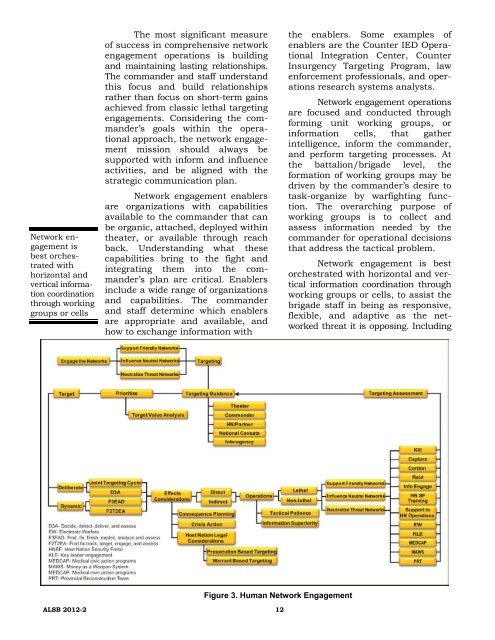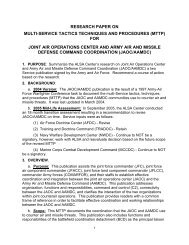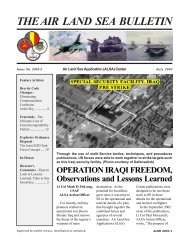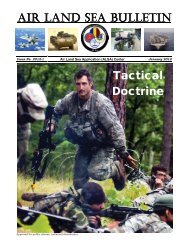AIR LAND SEA BULLETIN Attack the Network - ALSA
AIR LAND SEA BULLETIN Attack the Network - ALSA
AIR LAND SEA BULLETIN Attack the Network - ALSA
Create successful ePaper yourself
Turn your PDF publications into a flip-book with our unique Google optimized e-Paper software.
<strong>Network</strong> engagement<br />
is<br />
best orchestrated<br />
with<br />
horizontal and<br />
vertical information<br />
coordination<br />
through working<br />
groups or cells<br />
The most significant measure<br />
of success in comprehensive network<br />
engagement operations is building<br />
and maintaining lasting relationships.<br />
The commander and staff understand<br />
this focus and build relationships<br />
ra<strong>the</strong>r than focus on short-term gains<br />
achieved from classic lethal targeting<br />
engagements. Considering <strong>the</strong> commander’s<br />
goals within <strong>the</strong> operational<br />
approach, <strong>the</strong> network engagement<br />
mission should always be<br />
supported with inform and influence<br />
activities, and be aligned with <strong>the</strong><br />
strategic communication plan.<br />
<strong>Network</strong> engagement enablers<br />
are organizations with capabilities<br />
available to <strong>the</strong> commander that can<br />
be organic, attached, deployed within<br />
<strong>the</strong>ater, or available through reach<br />
back. Understanding what <strong>the</strong>se<br />
capabilities bring to <strong>the</strong> fight and<br />
integrating <strong>the</strong>m into <strong>the</strong> commander’s<br />
plan are critical. Enablers<br />
include a wide range of organizations<br />
and capabilities. The commander<br />
and staff determine which enablers<br />
are appropriate and available, and<br />
how to exchange information with<br />
Figure 3. Human <strong>Network</strong> Engagement<br />
ALSB 2012-2 12<br />
<strong>the</strong> enablers. Some examples of<br />
enablers are <strong>the</strong> Counter IED Operational<br />
Integration Center, Counter<br />
Insurgency Targeting Program, law<br />
enforcement professionals, and operations<br />
research systems analysts.<br />
<strong>Network</strong> engagement operations<br />
are focused and conducted through<br />
forming unit working groups, or<br />
information cells, that ga<strong>the</strong>r<br />
intelligence, inform <strong>the</strong> commander,<br />
and perform targeting processes. At<br />
<strong>the</strong> battalion/brigade level, <strong>the</strong><br />
formation of working groups may be<br />
driven by <strong>the</strong> commander’s desire to<br />
task-organize by warfighting function.<br />
The overarching purpose of<br />
working groups is to collect and<br />
assess information needed by <strong>the</strong><br />
commander for operational decisions<br />
that address <strong>the</strong> tactical problem.<br />
<strong>Network</strong> engagement is best<br />
orchestrated with horizontal and vertical<br />
information coordination through<br />
working groups or cells, to assist <strong>the</strong><br />
brigade staff in being as responsive,<br />
flexible, and adaptive as <strong>the</strong> networked<br />
threat it is opposing. Including





